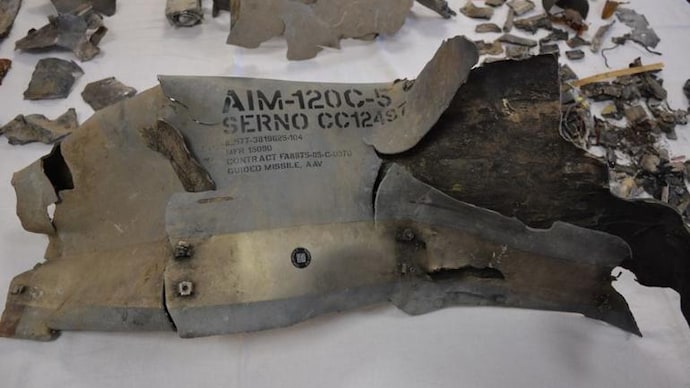SOURCE: RAUNAK KUNDE / NEWS BEAT / IDRW.ORG


A new design of the CATS Hunter Air-Launched Cruise Missile (ALCM), part of India’s Combat Air Teaming System (CATS) program, has surfaced, revealing a significant departure from the prototype showcased by Hindustan Aeronautics Limited (HAL) at Aero India 2021. The updated CATS Hunter, now powered by the indigenous PTAE-7 engine, boasts a range exceeding 350 km and a sleek, stealth-oriented configuration, as seen in images circulating .
The CATS Hunter ALCM, initially unveiled as part of the broader CATS ecosystem to complement manned fighters with unmanned systems, has evolved dramatically. The earlier design at Aero India 2021 featured a more conventional missile layout with prominent wings and a cylindrical body, resembling traditional cruise missiles like the Storm Shadow. The newly revealed design, however, adopts a streamlined, low-observable profile with a flattened, angular body, likely aimed at reducing its radar cross-section (RCS). The missile appears to have blended winglets and a more integrated exhaust, suggesting a focus on stealth and aerodynamic efficiency—key for penetrating contested airspace along India’s borders with Pakistan and China.
Continue readingSOURCE: RAUNAK KUNDE / NEWS BEAT / IDRW.ORG


The Indian Air Force (IAF) is set to enhance its air combat capabilities with the induction of the Astra MkII Beyond Visual Range Air-to-Air Missile (BVRAAM), which has quietly entered Limited Series Production (LSP). This advanced missile, developed by the Defence Research and Development Organisation (DRDO), marks a significant milestone in India’s pursuit of self-reliance in defense technology and strengthens its strategic posture in the region.
The Astra MkII, designed to outperform the Chinese PL-15E missile showcased by the Pakistan Air Force (PAF) on its J-10CE and JF-17 fighters, boasts a superior range and advanced technological features. Extensive testing of the missile, including captive flight trials on the IAF’s Su-30 MKI platform, has paved the way for its LSP approval earlier this year. Reports from idrw.org indicate that the Astra MkII has been tested in unguided mode and equipped with a new Active Electronically Scanned Array (AESA) seeker, enhancing its precision and effectiveness against modern aerial threats.
Continue readingSOURCE: RAUNAK KUNDE / NEWS BEAT / IDRW.ORG


In a significant boost to India’s push for self-reliance in defense, the Indian Air Force (IAF) and Navy are poised to integrate the BrahMos-NG (Next Generation) supersonic cruise missile into their Rafale fleets, following a breakthrough agreement with Dassault Aviation. The French manufacturer has acceded to India’s demand for greater integration of indigenous weapon systems, marking a pivotal step in enhancing the Rafale’s role in India’s multi-platform strategy. With trials of the 1.3-ton BrahMos-NG scheduled for 2026 and production planned at a new facility in Lucknow, the missile is set to become a cornerstone of India’s aerial firepower, arming not only the Rafale but also the Su-30MKI and Tejas Mk1A.
The BrahMos-NG, a lighter and more compact version of the BrahMos supersonic cruise missile, weighs 1.3–1.4 tons and measures 6 meters in length with a 50 cm diameter—making it 50% lighter and 3 meters shorter than its predecessor while retaining a 290 km range and Mach 3.5 speed. Developed by BrahMos Aerospace, a joint venture between India’s DRDO and Russia’s NPO Mashinostroyeniya, the missile is designed for multi-platform deployment, including air, land, sea, and submarine launches. Its reduced radar cross-section (RCS) and advanced seeker with AESA radar enhance its stealth and precision, making it a formidable weapon for modern warfare. The IAF has already committed to procuring 400 BrahMos-NG missiles at a cost of 8,000 crore, with deliveries expected within five years of production commencement.
Continue readingSOURCE: AFI


In a recent interview with Sputnik India, Air Marshal RGK Kapoor (Retd.), the Indian Air Force (IAF) spokesperson during the 2019 Balakot airstrike, reaffirmed India’s claim of shooting down a Pakistani F-16 during the aerial skirmish that followed. Kapoor’s statement, “The weapons went where they were supposed to go, and even if Pakistan doesn’t accept it, the F-16 was shot down,” underscores the IAF’s confidence in its account of the February 27, 2019, dogfight over the Line of Control (LoC).
The Balakot airstrike, conducted on February 26, 2019, saw IAF Mirage 2000 jets target a Jaish-e-Mohammed (JeM) terrorist training camp in Balakot, Pakistan, in retaliation for the Pulwama attack that killed 40 Indian CRPF personnel. The strike escalated tensions, leading to a Pakistani counterstrike the following day. On February 27, the Pakistan Air Force (PAF) attempted to target Indian military installations, prompting a swift response from the IAF.
Continue readingSOURCE: AFI


In a significant escalation of electronic warfare (EW) along the Indo-Pak border, India has rapidly deployed high-frequency jamming systems designed to disrupt Global Navigation Satellite System (GNSS) signals, including GPS, GLONASS, and BeiDou, as reported across multiple posts on X on April 29, 2025. These systems, strategically positioned near the Line of Control (LoC) in Jammu and Kashmir, aim to degrade Pakistan’s situational awareness, navigation accuracy, and precision-guided munitions capabilities, further straining already tense relations between the two nuclear-armed neighbors.
The deployment follows a series of recent provocations, including ceasefire violations along the LoC, clashes in Kupwara, and a deadly attack on April 29, 2025, known as the Pahalgam massacre, where 26 tourists were killed by The Resistance Front, a shadow group of the Pakistan-based Lashkar-e-Taiba. India’s decision to scrap the 2021 LoC ceasefire agreement in response has set the stage for this aggressive EW strategy. By targeting GNSS signals, India seeks to impair Pakistan’s military operations, which heavily rely on satellite navigation for drone navigation, troop movements, and precision-guided munitions like the Babur missile.
Continue readingSOURCE: AFI


Tata Advanced Systems Limited (TASL) is set to make a significant impact at the Defence Exhibition Athens (DEFEA) 2025, taking place from May 6th to 8th in Athens, Greece. The company announced its participation via posts on X, inviting attendees to visit its booth at Hall 3, C-24, where it will display its cutting-edge defense and aerospace technologies. Among the highlights are the Advanced Towed Artillery Gun System (ATAGS), the Wheeled Armoured Platform (WhAP) 8×8, and the ALS-50, a vertical take-off and landing (VTOL) unmanned aerial vehicle (UAV) system, showcasing India’s growing prowess in indigenous defense manufacturing.
The ATAGS, developed in collaboration with the Defence Research and Development Organisation (DRDO), is a 155mm/52 caliber howitzer designed to provide superior firepower for the Indian Army. Known for its advanced automation and ability to operate in diverse terrains, ATAGS has already completed successful firing trials and is positioned as a cornerstone of India’s artillery modernization. Its presence at DEFEA 2025 signals TASL’s intent to market this system globally, especially after securing export deals like the 150 WhAP units to the Royal Moroccan Armed Forces in 2024.
Continue readingSOURCE: AFI


Kanpur-based MKU Limited has secured a significant win with its Kavro Ballistic Helmets being selected by SWAT teams, as announced in posts on X on April 29, 2025. Designed to match the intensity of SWAT operations, the Kavro series—already in service with the Indian Army and undergoing trials abroad—brings combat-proven protection and cutting-edge features to elite law enforcement units. With India pushing for self-reliance in defense manufacturing, this selection underscores MKU’s growing influence in both military and paramilitary sectors, though it also raises questions about whether domestic production can meet the rigorous demands of global tactical teams.
The Kavro helmets, notably the high-cut models like the Kavro Doma 360 and MCH-126 T, are engineered for high-stakes environments. Their high-cut shell design enhances situational awareness by providing an unobstructed field of view and compatibility with communication headsets, crucial for SWAT teams operating in dynamic urban settings. Weighing as little as 1.45 kg in the high-cut combat (HCH) configuration, the helmets prioritize mobility without sacrificing protection. They offer uniform defense against high-velocity threats, including AK-47-fired 7.62×39 mm mild steel core (MSC) bullets, as well as 7.62×51 mm and 5.56×45 mm NATO rounds, with a back face signature (BFS) of less than 20 mm. This low BFS minimizes behind-helmet blunt trauma (BHBT), reducing the risk of concussions—a critical factor in close-quarters combat where every second counts.
Continue readingSOURCE: BLOOMBERG


Indian trade negotiators are planning to showcase the country’s large pipeline of Boeing Co. plane orders and the potential for more to come as they seek a favorable deal with the US, people familiar with the matter said.
The plan is to get Indian carriers’ existing orders and under-negotiation deals with the American planemaker counted in discussions for a bilateral trade pact that could potentially shield the country from higher US tariffs, the people said, asking not to be named as the talks are private.
Continue readingSOURCE: PTI

India on Wednesday (April 30, 2025) banned Pakistan airlines from using its airspace amid escalating tensions with the neighbouring country in the wake of the Pahalgam terror attack. Sources said that a NOTAM (Notice to Airmen) has been issued that bars Pakistan airlines from using the Indian airspace.
The development comes a week after Pakistan barred Indian carriers from using its airspace.
Continue readingSOURCE: ANI
)

The Ministry of Defence has extended the ban on six defence firms for an additional three years, continuing the restriction on their dealings with the ministry. The companies include Singapore Technologies Kinetics Ltd, Israel Military Industries Ltd, TS Kisan and Co Pvt Ltd, RK Machine Tools Ltd, Rheinmetall Air Defence (Zurich), and Corporation Defence (Russia).
These companies were initially debarred from doing business with the Ministry of Defence for 10 years, starting April 11, 2012, with the ban first extended to three more years in 2022.
Continue readingSOURCE: ANI


Amid the ongoing stand-off between India and Pakistan over the Pahalgam attack in Jammu and Kashmir, the Pakistani military, it seems, has started preparing for Indian military action.
Sources in the country’s military establishment said on Wednesday that Pakistani Navy vessels, including its frigates and submarines, have already positioned themselves in their respective harbours in the sea to be able to tackle any possible Indian movement.
Continue readingSOURCE: PTI


Lt Cdr Divya Sharma, Dornier pilot of an elite naval air squadron in the Andaman and Nicobar Command (ANC), has become the “first woman” to be a Qualified Flying Instructor of the Indian Navy.
In a post on X on Wednesday, the ANC also shared some photographs.
“Lt Cdr Divya Sharma, Dornier pilot of INAS 318 at #INSUtkrosh #ANC, creates history as 1st woman Qualified Flying Instructor of #IndianNavy! Trailblazing skies & inspiring generations. #NariShakti #WomenInUniform #QFI #NavalComponent #ANC,” it posted on the micro-blogging platform.
INS Utkrosh is a naval air station at Port Blair, Andaman and Nicobar Islands.
SOURCE: PTI


Indian airlines are likely to face additional weekly expenses of Rs 77 crore for international flights operated from north Indian cities as the airspace curbs result in increased fuel consumption and longer flight durations.
An analysis of the number of overseas flights and back-of-the-envelope calculations based on increased flight time as well as approximate expenses by PTI showed that the additional monthly operational costs could be over Rs 306 crore.
Continue readingSOURCE: PTI
)

India has warned Pakistan against its unprovoked firings along the Line of Control (LoC) in Jammu and Kashmir as the directors general of military operations of the two armies spoke on the hotline amid the escalating tensions over the Pahalgam terror attack.
Pakistan has been resorting to firings on the Indian side of the LoC since Friday night in violation of a ceasefire understanding and the Indian Army responded to them “appropriately”, according to military sources.
Continue readingSOURCE: PTI
)

India on Wednesday reached out to Denmark in line with its diplomatic overdrive to apprise the non-permanent members of the UN Security Council about the brutal Pahalgam terror attack with cross-border linkages.
On Tuesday, External Affairs Minister S Jaishankar spoke to his counterparts from seven non-permanent member nations of the UN Security Council. Jaishankar held a phone conversation with his Danish counterpart Lars Lokke Rasmussen on Wednesday and is understood to have conveyed to him India’s resolve to bring the perpetrators of the April 22 attack to justice.
Continue reading